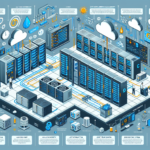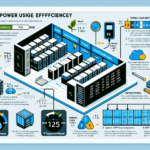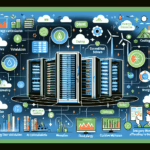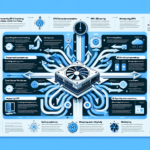Hot aisle and cold aisle containment are strategies used in data centers to improve cooling efficiency and reduce energy consumption. Both techniques focus on separating hot and cold airflows to prevent mixing, which can lead to inefficiencies in cooling systems. Here’s a detailed explanation of each:
Cold Aisle Containment:
Cold aisle containment involves enclosing the cold aisle in a data center to ensure that cold air from the cooling systems is directed specifically to the server equipment. This strategy prevents cold air from mixing with hot air and ensures that the servers receive efficient cooling.
Key Features:
– Cold Aisle Design: Rows of server racks are arranged so that the front (air intake side) of the servers faces the cold aisle, where cold air is supplied by Computer Room Air Conditioning (CRAC) units or other cooling systems.
– Enclosure: The cold aisle is enclosed with physical barriers, such as doors and ceilings, to keep the cold air contained.
– Purpose: Cold air is delivered directly to the server intakes, ensuring a consistent temperature for efficient operation.
Advantages:
– Ensures a predictable cold air supply to equipment.
– Improves cooling efficiency by directing cold air precisely where it is needed.
– Reduces energy consumption by avoiding the need for overcooling the entire data center.
Hot Aisle Containment:
Hot aisle containment involves enclosing the hot aisle in a data center to capture and isolate the hot air expelled by the server equipment. The hot air is then directed back to the cooling systems for processing and recirculation.
Key Features:
– Hot Aisle Design: Rows of server racks are arranged so that the back (air exhaust side) of the servers faces the hot aisle, where hot air is expelled.
– Enclosure: The hot aisle is enclosed with physical barriers, such as doors and ceilings, to contain the hot air and prevent it from mixing with the cold air.
– Purpose: Hot air is separated from the rest of the data center environment and returned to the cooling system.
Advantages:
– Prevents hot air from recirculating to the cold aisle, reducing the need for excessive cooling.
– Improves cooling efficiency and temperature control.
– Reduces operational costs by optimizing cooling system performance.
Key Differences Between Hot Aisle and Cold Aisle Containment:
| Aspect | Cold Aisle Containment | Hot Aisle Containment |
|—————————|——————————————-|——————————————-|
| Airflow Management | Cold air is enclosed and directed to servers. | Hot air is enclosed and directed back to cooling systems. |
| Rack Orientation | Front of racks faces the cold aisle. | Back of racks faces the hot aisle. |
| Energy Efficiency | Focuses on delivering cold air efficiently. | Focuses on capturing and redirecting hot air efficiently. |
| Implementation | Encloses the cold aisle with barriers. | Encloses the hot aisle with barriers. |
Which Is Better?
The choice between hot aisle and cold aisle containment depends on the specific design, layout, and cooling strategy of the data center. However:
– Cold Aisle Containment is often preferred when optimizing for server intake temperature consistency.
– Hot Aisle Containment is typically more energy-efficient for larger data centers with high-density server configurations, as it allows the cooling system to better manage the hot air directly.
Both approaches are effective at improving cooling efficiency, reducing energy consumption, and maintaining optimal temperatures for servers and other critical IT infrastructure.
If you’re planning containment for your data center, consider factors like existing airflow design, cooling system capabilities, equipment density, and energy efficiency goals.





